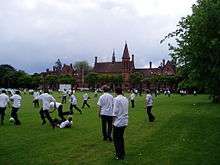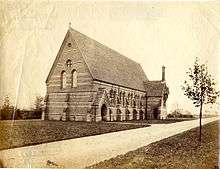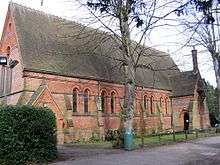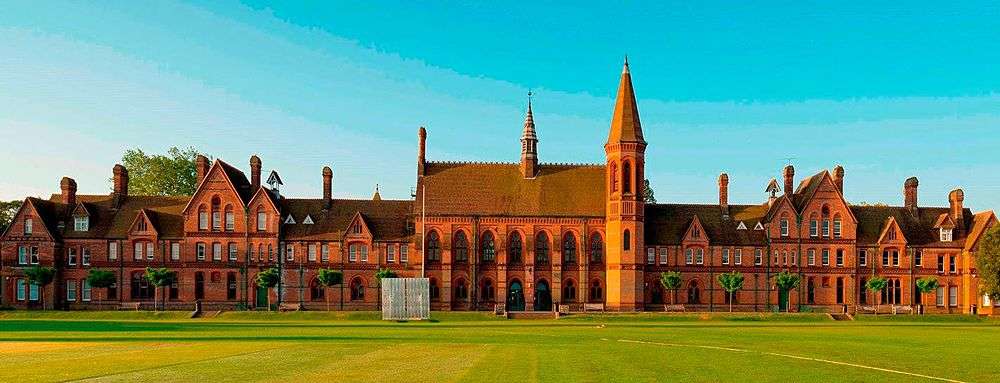Reading School
|
| |
| Motto |
Floreat Redingensis (Latin: May Reading [School] flourish) |
|---|---|
| Established |
1125 1486 (refounding) |
| Type |
Grammar academy Day and boarding school |
| Religion | Church of England |
| Headmaster | A M Robson |
| Chaplain | G Cornelissen |
| Deputy Headmaster | C Evans |
| Founder | Henry VII |
| Location |
Erleigh Road Reading Berkshire RG1 5LW United Kingdom |
| DfE URN | 136449 Tables |
| Ofsted | Reports Pre-academy reports |
| Students | 867 |
| Gender | Boys |
| Ages | 11–18 |
| Houses |
School (green) County (magenta) East (pink/cerise) West (yellow/gold) Laud (light blue) |
| Colours |
Navy Blue, Silver |
| Publication | Floreat Redingensis |
| Boarding houses |
East Wing South House |
| Former pupils | Old Redingensians |
| Website | www.reading-school.co.uk |
Reading School is a grammar school with academy status for boys in the English town of Reading, the county town of Berkshire. It traces its history back to the school of Reading Abbey, making it one of the oldest schools in England. There are no tuition fees for day pupils, and boarders only pay for food and lodging.
History


Reading School was founded as part of Reading Abbey. The date of the Abbey's charter, 29 March 1125, is taken as the foundation date, making it the 10th oldest school in England, although there are hints that there may have been a school running in Reading before this.[1]
In 1486, the school was refounded as a "Free Grammar School" ("free" here meaning teaching the free, or liberal, arts, not that no fees were paid) by Henry VII on the urging of the then Abbot, John Thorne. From at least this time, the School was housed in the former Hospitium of St John. The main building of the hospitium still exists, but the refectory, which once housed the schoolroom, was demolished in 1785 and Reading Town Hall now stands on the site.[2][3]
After the dissolution of Reading Abbey in 1539, the school fell under the control of the corporation of Reading, its status being confirmed by Letters Patent issued by Henry VIII in 1541. This was reconfirmed in the Royal Charter granted to the corporation of Reading by Elizabeth I in 1560, which made the corporation liable for the salary of the headmaster and gave them the power of appointing him.
There were interruptions to schooling in 1665, when Parliament, forced out of London by the Great Plague, took over the schoolhouse. The civil war also interrupted, with the school being used as a garrison by royalist forces. The school prospered at the start of the nineteenth century but by 1866 disagreements between the town and school, which had become increasingly exclusive, and problems with the lease on the school buildings had led to falling numbers and the school closed briefly when (according to legend), the inspectors, on asking to see the school, were told "He's runned [sic] away".
The school soon restarted, however, with the Reading School Act (1867) setting out its administration and funding. The foundation stone for new buildings, designed by Alfred Waterhouse, was laid by the Prince of Wales in 1870, and in 1871 the school moved in. In 1915 Kendrick Boys' School (founded in 1875 from the legacy of John Kendrick), which had a large endowment but poor facilities, was taken over by Reading, which was poorly funded but had excellent facilities – this caused considerable controversy at the time but was ultimately seen as successful.
The 1944 Education Act saw the abolition of fees (apart from boarding charges), with the cost of education now being met by the local authority. The 1960s saw the rise of comprehensive education, which threatened Reading's status. However, Reading was exempted in 1973 (along with the girls' grammar school in Reading, Kendrick) after a petition of over 30,000 local people (a third of the voters of Reading) was handed to the government.
In 1986 the school celebrated the quincentenary of its refounding, and was graced by a visit by Queen Elizabeth II. A history of the school by Michael Naxton was published that year by Reading School Parents' Association.
On 6 July 2007 Reading School was officially designated as the landing site for the Thames Valley and Chiltern Air Ambulance when it needs to transport patients to the nearby Royal Berkshire Hospital. Previously, seriously injured or ill patients from the Reading area had to be flown either to Wexham Park Hospital near Slough, or to the John Radcliffe Hospital in Oxford for treatment. The new arrangement means that the school field can now be used for emergency touchdowns. Patients are transported by land ambulance from the school to the hospital's accident and emergency department across the road.[4] While this arrangement was only made official in 2007, the school field had been unofficially used on several occasions by the Thames Valley and Chiltern Air Ambulance in previous years.
In 2016, it was confirmed that a new house would be introduced to cater for a fifth form in Year 7 and the increase in admission numbers to 150. Laud house, named after William Laud, has the colour light blue.
School site


The current school site consists of a main block (with two wings), a Science block, the Page building, the John Kendrick building, South House, Music School (formerly known as Junior School) and a chapel. The main school building, the chapel, South House and the building to the east of South House have all been designated as Grade II listed buildings by English Heritage.[5][6][7][8]
The main block consists of 11 teaching rooms, as well as most of the school's administrative rooms. The classrooms here are mainly used to teach English and Economics; but the two Drama studios are used exclusively for Drama. The block is built around a central quadrangle, with the main teaching rooms down the east side, and the Drama studios to the west. Over the northern entrance to the 'quad' is Big School, the school hall. There are also two wings: East Wing and West Wing. East Wing serves as a boarding house, while West Wing houses the staff room, sixth form common room, administrative entrance and reception, the newly renamed 'Middleton room' (ICT suite) and Religious Studies department.
The Science block, situated on the south-east of the site, has recently completed refurbishment in April 2017, and contains two brand new computing rooms, as well as three Physics labs, four new Biology labs and four Chemistry labs, three new and one from previously. The old Lecture Theatre has recently been fully refurbished. The old Chemistry labs were demolished to make way for the completely new Biology and Chemistry facilities, with the Physics labs just being refurbished.
The old Biology labs, on the very far south-east of the site, have been refurbished and now house 3 History rooms and the History Office.
South House is a boarding house, although it also contains four teaching rooms and the 'Eppstein room', which functions as a secondary Mathematics office.
The Page Building, located between South House and the Science block, contains two Art rooms, two Computer Science labs, three Mathematics rooms, the main Mathematics office and an IT suite.
The John Kendrick building, opened in 2002, is to the west of the site, housing the Learning Resource Centre (Library), two Geography rooms, two Latin and Classics rooms and four language classrooms, as well as the Geography Office and a combined Classics, Latin and Languages Office. The adjoined 'Coach House' contains another Geography room, another Language room, and Student Support Facilities.
The Chapel is where the school's Christmas, Remembrance and Easter services take place, and every student attends once a week (with the exception of Year 13 Daniel Salter who, upon entreating the then chaplain Chris Evans with a convincing argument, was excused permanently). The Chapel has four groups of pews, facing towards the central aisle. Above the entrance is the organ, and at the far end is the altar and vestry. In 2017, a student created an online petition to make chapel optional for students, particularly for students who were not Christian, which got over 250 signatures from students. However, it was unsuccessful, due to "school traditions", despite the overwhelming response to the petition.
Music School (formerly Junior School) has a teaching room, a keyboard room, a hall (used for orchestra and choir practices) and four smaller individual teaching rooms (used for individual music lessons). The school currently also uses the back area of Music School for art lessons. The building is situated at the far end of the drive, on the left of the main entrance.
Plans have also been developed for improved sports and science facilities as part of the "1125 campaign". Work on improving science facilities began in 2015 and was completed in Spring 2017 as stated above. Work on the new sports facilities has begun, with a new fitness suite made on the location of the old squash courts next to chapel, and refurbishments on the gym and changing rooms completed. [9]
School Terrace
Inspections and awards
An OFSTED report concluded that "examination results place the school in the top five per cent nationally", "Pupils' attitudes to learning are outstanding" and "The school goes to exceptional lengths to broaden and enrich the education of all pupils". The 2005 Key Stage 3 results were both the best in the country for value-added and for the average points score of each student.[10] In the 2004 school league tables for England (including fee-paying schools), it came eighth for GCSE-level results (average 602.5 points), 106th for A-level results (average 409.3 points) and 170th for value-added between ages 11 and 16 (score of 1037.7 compared with a baseline of 1000). It has recently become a DFES specialist school for the Humanities, specialising in English, Geography and Classics – the first school to specialise in Classics – despite entry being selected by Mathematics and verbal and non-verbal logic ability. The School prides itself on offering A-Level Latin to any student who has an interest in studying the subject. The School will also offer Ancient Greek if numbers permit.
In 2005 the school was awarded the highly prestigious Sportsmark gold award for a four-year period. In the same year Reading was one of just 35 schools nationally to be made a Microsoft Partner School.[11] Reading School has had a partnership with Akhter Computers in Harlow, Essex, since 1998. The company has installed networks throughout the school and in the boarding house. It has also furnished the library with a special system which enables the school to record, edit and distribute video across the network.[12]
In 2007, the school was identified by the Sutton Trust as one of only 20 state schools among the 100 schools in the UK responsible for a third of admissions to Oxford and Cambridge Universities over the five preceding years. 16.0% of pupils went to Oxbridge and a 62.1% in total went to universities identified by the Sutton Trust as "top universities".[13] In July 2011, the school was further identified by the Sutton Trust as the third best state school, and among the top 30 schools in the country, for proportion of higher education applicants accepted at Oxford and Cambridge Universities. The report found that 16.7% of pupils were accepted to Oxbridge and 81.5% were accepted to the highly selective Sutton Trust 30 universities over the previous three years.[14]
Reading School was given the prestigious "State School of the Year" award by The Sunday Times newspaper in 2010, in recognition of the school's academic achievements and community orientated ethos.[15]
Subjects taught
| Subject | Taught at KS3 | Taught at KS4 | Taught at Sixth Form |
|---|---|---|---|
| Ancient History Classical Civilisation |
Compulsory[1] | Yes | If demand is sufficient |
| Art | Compulsory | Yes | Yes |
| Biology | Compulsory | Compulsory | Yes |
| Chemistry | Compulsory | Compulsory | Yes |
| Computer Science | Compulsory | Yes | Yes |
| Drama Theatre Studies |
Compulsory | Yes | If demand is sufficient |
| Economics | No | Yes | Yes |
| Electronics | Compulsory during Computer Science | If demand is sufficient | No |
| English | Compulsory | Compulsory | Literature only |
| French | Compulsory in Year 7[2] | Yes[3] | Yes |
| Geography | Compulsory | Yes | Yes |
| German | Compulsory in Year 7[2] | Yes[3] | Yes |
| History | Compulsory | Yes | Yes |
| Latin | Compulsory[1][2] | Yes[3] | Yes |
| Mandarin Chinese | No | No | If demand is sufficient |
| Mathematics[4] | Compulsory | Compulsory | Yes |
| Music | Compulsory | Yes | Yes |
| Philosophy Religious Studies |
Compulsory | Compulsory[5] | No |
| Physical Education | Compulsory | Yes[6] | Yes[6] |
| Physics | Compulsory | Compulsory | Yes |
| PSHE[7] | Compulsory | Compulsory | Yes |
| Spanish | Compulsory in Year 7[2] | Yes[3] | Yes |
| Student Leadership[7] | Compulsory | Year 10 only | No |
1.^ ^ Latin is compulsory until Year 9, where the lower sets do Ancient History instead. Those who didn't choose to do Latin for GCSE can choose to do Ancient History instead, for the remainder of Year 9.
2.^ ^ ^ ^ French, German, Spanish and Latin are compulsory in Year 7. In Year 8 students must take 2 modern languages and Latin.
3.^ ^ ^ ^ At least one ancient or modern language must be taken for the GCSEs.
4.^ Additional Maths is taken by some students at the same time as their GCSEs. Further Maths is optional at A Level, with some students being able to take it in one block with Maths.
5.^ The top half of the year take an externally-assessed AS-level Philosophy exam at the end of Year 10. Those who score a B or higher can either opt-out of the subject, continue onto the A2 or redo the exam the following year. Those who didn't score a B or higher can redo the exam the following year. The rest of the year will take an externally-assessed GCSE short course RS exam at the end of Year 11, though some exceptions can take the AS Philosophy exam instead.
6.^ ^ In the sixth form, P.E. can optionally be taken as an examined A-Level. Those that do not do this must still take part in games weekly, though this is not examined or graded in any way, or must take part in Community Service during Games lessons. In Years 10 and 11, certain students are given the option of taking the GCSE as an additional subject. All other students must still complete Games lessons.
Notable headmasters
- c.1540: Leonard Coxe
- c.1555: Julian Palmer (1533–1556) Protestant martyr
- 1588-1589: Thomas Braddock
- 1716–1750: Haviland Hiley
- 1781–1830: Dr Richard Valpy (1754–1836)
- 1830–1839: Rev. Francis Edward Jackson Valpy (1797-1882), son of Dr Richard Valpy
- 1871–1877: Thomas Henry Stokoe
- 1894–1914: William Charles Eppstein
- 1914–1939: George Keeton
- 1939–1966: Charles Kemp
Notable "Old Redingensians" (former students)
Deceased Old Redingensians (chronological order)
| Name | Year of birth | Year of death | Notable achievements |
|---|---|---|---|
| Sir Thomas White | 1492 | 1567 | Founder of St John's College, Oxford and Lord Mayor of London in 1553 |
| Sir Francis Moore | 1559 | 1621 | MP for Reading |
| John Blagrave | c.1561 | 1611 | Mathematician |
| William Laud | 1573 | 1645 | Chancellor of the University of Oxford 1629–1645, Archbishop of Canterbury, 1633–1645, beheaded in 1645 during the Civil War |
| John Kendrick | 1573 | 1624 | Elizabethan/Jacobean merchant and philanthropist |
| Daniel Blagrave | 1603 | 1668 | Regicide (signatory of the death warrant of Charles I in 1649). Escaped to exile in Aachen at the Restoration in 1660 |
| Sir Thomas Stampe (or Stamp) | Lord Mayor of the City of London in 1691 | ||
| Sir Constantine Phipps | 1656 | 1723 | Lord Chancellor of Ireland |
| Thomas Noon Talfourd | 1795 | 1854 | Judge and writer |
| Horace William Wheelwright | 1815 | 1865 | Lawyer, hunter, naturalist and writer |
| Captain Hastings Harington | 1832 | 1861 | Awarded the Victoria Cross as a lieutenant with the Bengal Artillery for conspicuous gallantry in the relief of Lucknow, 1857; died at Agra |
| Joseph Wells | 1855 | 1929 | Warden of Wadham College, Oxford 1913–1927, Vice-Chancellor of the University of Oxford 1923–1926 |
| Sir Hugh Percy Allen | 1869 | 1946 | Director of the Royal College of Music, Professor of Music in the University of Oxford |
| William Norman Rae | 1886 | 1964 | Professor of Chemistry, Royal College of Surgeons in Ireland |
| Herbert Leader Hawkins FRS (elected 1937) | 1887 | 1968 | President of the Palaeontological Society, professor of palaeontology, University of Reading, authority on sea urchins |
| Arthur Negus OBE | 1903 | 1985 | Broadcaster and antiques expert |
| Norman Gash | 1912 | 2009 | Historian, professor of modern history, University of St Andrews |
| John Boulting &
Roy Boulting |
1913
1913 |
1985
2001 |
Film directors and producers |
| Horace Edgar "Tom" Dollery | 1914 | 1987 | Warwickshire and England cricketer |
| John Minton | 1917 | 1957 | Artist, lecturer and teacher |
| George William Series FRS (elected 1971) | 1920 | 1995 | Physicist, professor of physics, University of Reading |
| Sir Clifford Charles Butler | 1922 | 1999 | Physicist, co-discoverer of hyperons and mesons |
| J. L. Ackrill | 1921 | 2007 | Professor of Classics at the University of Oxford |
| Lord Roper of Thorney Island | 1935 | 2016 | Politician |
Living Old Redingensians (alphabetical order)
| Name | Year of birth | Notable achievements |
|---|---|---|
| Paul Badham | 1942 | Professor of Theology and Religious Studies, University of Lampeter, Director of the Alister Hardy Religious Experience Research Centre |
| George W. Bernard | 1950 | Professor of Early Modern History at the University of Southampton |
| Ross Brawn | 1954 | Former Technical Director of Benetton and Ferrari Formula 1 teams, former Team Principal of Honda F1, former owner of Brawn GP, former Team Principal of Mercedes Grand Prix and currently Formula One Managing Director of Motorsports. |
| Mark Field | 1964 | MP (2001-) - Vice Chairman (International) of the Conservative Party (2015-), Minister of State (Foreign and Commonwealth Office) (2017-). |
| Damian Green | 1956 | MP (1997-) - Minister of State for Immigration (2010-12), Minister of State for Policing and Criminal Justice (2012-2014), Secretary of State for Work and Pensions (2016-2017), First Secretary of State (2017)[16][17] |
| Oliver Heald | 1954 | MP (1992-) – Solicitor General for England and Wales (2012-2014), Minister of State for Courts and Justice (2016-) |
| Christopher Renshaw | 1951 | Theatre Director |
| Oliver Shah | 1983 | Business Editor of the Sunday Times |
| Andrew Smith | 1952 | former MP (1987-2017) – Chief Secretary to the Treasury (1999-2002), Secretary of State for Work and Pensions (2002-2004) |
| David Warburton | 1965 | MP (2015-), composer and businessman |
Bibliography
- Michael Naxton. The History of Reading School. Ringwood, Hampshire: Pardy Printers, 1986.
- John Oakes and Martin Parsons. Reading School: The First 800 Years. Peterborough: DSM, 2005. ISBN 0-9547229-2-2.
- John Oakes and Martin Parsons. Old School Ties: Educating for Empire and War. Peterborough: DSM, 2001. ISBN 0-9536516-6-5. (The stories of Old Redingsians in World War I).
- A History of Cricket at Reading School, 1987.
See also
References
- ↑ Michael Naxton (1986). The History of Reading School. Ringwood, Hampshire: Pardy Printers.
- ↑ Phillips, Daphne (1980). The Story of Reading. Countryside Books. p. 42. ISBN 0-905392-07-8.
- ↑ Phillips, Daphne (1980). The Story of Reading. Countryside Books. p. 88. ISBN 0-905392-07-8.
- ↑ Reading School – "New Landing Site for Air Ambulance". The South Central Ambulance Service NHS Trust Archived 27 September 2007 at the Wayback Machine.
- ↑ Main school building, Images of England reference no. 38922
- ↑ Lecture Theatre at Reading School, Images of England reference no. 38923
- ↑ South House, Images of England reference no. 38924
- ↑ Building to the east of South House, Images of England reference no. 38925
- ↑ Student
- ↑ "Grammar boys are simply the best". Reading Evening Post. 2006-03-30.
- ↑ Andrew Linnell. The Headmaster's Letter. The Old Redingensian, May 2005, p2 (PDF). Archived 21 February 2007 at the Wayback Machine.
- ↑ Case Study. Video Broadcast over the Network at Reading School (PDF) Archived 13 October 2006 at the Wayback Machine.
- ↑ "University Admissions by Individual Schools" (PDF). Sutton Trust. 2007. Archived from the original (PDF) on 25 February 2009.
- ↑ "Degrees of Success - University Chances by Individual School" (PDF). Sutton Trust. 2011. Archived from the original (PDF) on 17 December 2011.
- ↑ "Schools of the Year - State Secondary School of the Year 2010". The Sunday Times. 2010. Archived from the original on 7 March 2013.
- ↑ "Damian Green: May's loyal political friend and pro-EU advocate". The Guardian. 11 June 2017.
- ↑ "Damian Green sacked after 'misleading statements' on porn claims". BBC News. 20 December 2017.
